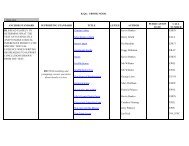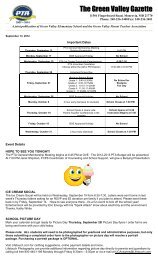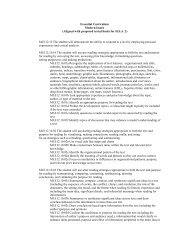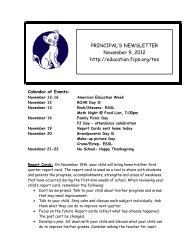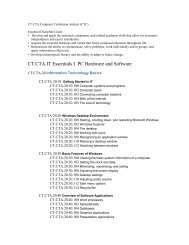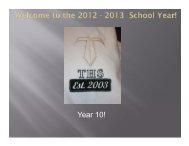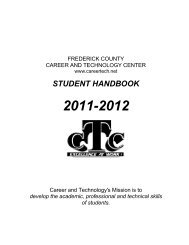Printable Self Guided Tour of the Arboretum - Frederick County ...
Printable Self Guided Tour of the Arboretum - Frederick County ...
Printable Self Guided Tour of the Arboretum - Frederick County ...
You also want an ePaper? Increase the reach of your titles
YUMPU automatically turns print PDFs into web optimized ePapers that Google loves.
Keep an eye out for <strong>the</strong> following<br />
trees as you walk through <strong>the</strong><br />
<strong>Arboretum</strong>.<br />
Upland Tree facts<br />
• The sassafras tree is unique because<br />
its branches hold three different<br />
shaped leaves. Its bark can be distilled<br />
and <strong>the</strong> remaining oil is used to<br />
make scent for soap.<br />
• The Black Gum is know as one <strong>of</strong> <strong>the</strong><br />
5 best shade trees in America. Black<br />
Gum trees grow very slowly and can<br />
live as long as 400 years.<br />
Mid-slope Tree facts<br />
• The Willow Oak is a fast growing tree<br />
that tolerates heat and drought very<br />
well. This makes it a great tree to<br />
plant along streets and in parks.<br />
• The slippery elm has bark that is used<br />
to make herbal tea. It has a soothing<br />
property that makes it sore throats<br />
and upset stomachs.<br />
Lowland Tree facts<br />
• The Eastern White Pine is <strong>the</strong> largest<br />
variety <strong>of</strong> pine that is native to Maryland.<br />
They can live to be 400 years<br />
old.<br />
• The quaking Aspen gets its name<br />
from <strong>the</strong> way its leaves shake in a<br />
breeze.<br />
South <strong>Frederick</strong><br />
<strong>Arboretum</strong><br />
<strong>Self</strong>-guided <strong>Tour</strong><br />
Lincoln Elementary School<br />
250 Madison St.<br />
<strong>Frederick</strong>, Md 21701<br />
Phone: 240-236-2694<br />
Fax: 240-236-2693<br />
On <strong>the</strong> Web: http://schools.fcps.org/essl/<br />
The History <strong>of</strong> The South <strong>Frederick</strong> <strong>Arboretum</strong><br />
The South <strong>Frederick</strong> <strong>Arboretum</strong> was established by a reforestation grant<br />
from <strong>Frederick</strong> <strong>County</strong>, Maryland. The arboretum was planned and organized<br />
by <strong>the</strong> Department <strong>of</strong> Natural Resources, The <strong>Frederick</strong> <strong>County</strong><br />
Forestry Board, and <strong>the</strong> Earth and Space Science Laboratory. The students<br />
and staff <strong>of</strong> South <strong>Frederick</strong> (2003-2004), <strong>the</strong> Community Commons,<br />
Master Gardeners <strong>of</strong> <strong>Frederick</strong>, <strong>the</strong> Operations Department <strong>of</strong><br />
<strong>Frederick</strong> <strong>County</strong> Public Schools, students from <strong>the</strong> Career and Technology<br />
School, and <strong>the</strong> City <strong>of</strong> <strong>Frederick</strong> helped to plant <strong>the</strong> trees. The “big<br />
planting’ took place on April 20, 2004.<br />
Every tree planted in this two-acre parcel is a “native species” and can<br />
be found growing throughout <strong>Frederick</strong> <strong>County</strong>. More than 265 trees<br />
representing 70 different species are growing in <strong>the</strong> arboretum. Large<br />
samples <strong>of</strong> rocks and minerals found in <strong>Frederick</strong> <strong>County</strong> were later<br />
added to <strong>the</strong> pathways to highlight <strong>the</strong> geology <strong>of</strong> <strong>the</strong> county.<br />
The arboretum was planted in three sections. The trees marked with<br />
green signs are considered “lowland” species and are found closer to<br />
streams and rivers. The trees marked with red signs are considered<br />
“upland trees” and are found on <strong>the</strong> mountains and at higher elevations<br />
<strong>of</strong> <strong>Frederick</strong>. The trees marked with black signs are considered to<br />
be “mid-slope” trees and are found between <strong>the</strong> lowland and upland<br />
trees <strong>of</strong> <strong>the</strong> county.<br />
Enjoy <strong>the</strong> 265 trees representing 70 different<br />
varieties currently growing in <strong>the</strong> South<br />
<strong>Frederick</strong> <strong>Arboretum</strong>.<br />
The arboretum has been designed<br />
to simulate a walk through <strong>Frederick</strong><br />
<strong>County</strong>: through <strong>the</strong> lowlands,<br />
across <strong>the</strong> piedmont, and to <strong>the</strong><br />
Catoctin Mountains. As you stroll<br />
through <strong>the</strong> arboretum, we hope<br />
you enjoy <strong>the</strong> variety <strong>of</strong> trees and<br />
rocks, <strong>the</strong> information presented,<br />
and <strong>the</strong> design <strong>of</strong> this small parcel<br />
<strong>of</strong> land within <strong>Frederick</strong> City.
A Lowland Area B Mid-slope Area C Upland Area<br />
As you walk through <strong>the</strong> <strong>Arboretum</strong>,<br />
imagine that you are hiking across <strong>the</strong><br />
nor<strong>the</strong>rn part <strong>of</strong> <strong>Frederick</strong> <strong>County</strong>. Your trip<br />
begins at <strong>the</strong><br />
Monocacy River<br />
along <strong>the</strong> Carroll<br />
<strong>County</strong> border. If<br />
you were actually<br />
on <strong>the</strong> river bank,<br />
you might notice<br />
smelly, black soil<br />
sticking to your<br />
boots. Here at <strong>the</strong><br />
arboretum, <strong>the</strong><br />
lowland area is<br />
represented by<br />
The sycamore is <strong>Frederick</strong><br />
<strong>County</strong>’s <strong>of</strong>ficial<br />
tree.<br />
<strong>the</strong> trees specific<br />
to this zone. There<br />
are certain trees in<br />
<strong>Frederick</strong> <strong>County</strong><br />
that like to grow in<br />
wetlands along streamside “riparian” areas.<br />
We see sycamore trees, as well as some<br />
silver maple trees reaching for <strong>the</strong> sky. We<br />
also see smaller river birch, box elder, black<br />
haw, and spicebush. Along with <strong>the</strong>se lowland<br />
species <strong>of</strong> trees you may also see<br />
some native wildlife. While robins, and blue<br />
jays, and o<strong>the</strong>r birds make <strong>the</strong>ir home here<br />
in <strong>the</strong> arboretum, in <strong>the</strong> lowlands along <strong>the</strong><br />
Monocacy and o<strong>the</strong>r wetland areas, you<br />
might see a great blue heron.<br />
The Red Chokeberry<br />
is aptly<br />
named, since<br />
eating <strong>the</strong> berries<br />
causes your<br />
throat to swell up.<br />
With just a few steps along <strong>the</strong> arboretum<br />
path you will enter <strong>the</strong> mid-slop region.<br />
This area makes up <strong>the</strong> majority <strong>of</strong><br />
<strong>the</strong> land in <strong>Frederick</strong> <strong>County</strong>. Here you will<br />
find oak, hickory and walnut trees that<br />
seem to be alive with<br />
squirrels. Some lone<br />
cedar trees lounge<br />
gracefully out in <strong>the</strong><br />
fields. In your yard<br />
you might find maple,<br />
cherry, and locust<br />
trees.<br />
Trees from <strong>the</strong> midslope<br />
area prefer<br />
moist to dry conditions,<br />
so <strong>the</strong> arbore-<br />
tum provides <strong>the</strong> perfect<br />
place. The soil<br />
here is typically red in<br />
color and much drier<br />
than <strong>the</strong> soil along <strong>the</strong><br />
The white oak is <strong>the</strong><br />
Maryland State<br />
Tree.<br />
river. Wildlife common to this area include<br />
deer, groundhogs, opossum, and red fox.<br />
In <strong>the</strong>se trees you might see nests built by<br />
sparrows, robins, finches and some birds <strong>of</strong><br />
prey. A Peregrine Falcon has recently<br />
made <strong>the</strong> <strong>Arboretum</strong> its home. Keep your<br />
eyes open and it<br />
might make an appearance<br />
during<br />
your walk.<br />
The Kentucky C<strong>of</strong>fee tree produces large<br />
pods with several “beans” or seeds which<br />
early pioneers roasted to make c<strong>of</strong>fee.<br />
Heading west through <strong>Frederick</strong><br />
<strong>County</strong> along <strong>the</strong> mid-slope area will<br />
take you to <strong>the</strong> Catoctin Mountain<br />
range. If you were hiking you would<br />
begin to see changes in <strong>the</strong> types <strong>of</strong><br />
trees growing here. The upland area<br />
can be divided into three sub-regions:<br />
<strong>the</strong> base, mountainside,<br />
and peak. Along<br />
<strong>the</strong> base <strong>of</strong> <strong>the</strong> mountains<br />
you would find<br />
tulip poplar, white<br />
ash, birch, and sugar<br />
maple. Fur<strong>the</strong>r up in<br />
elevation you would<br />
find mostly red oaks<br />
and shagbark hickories.<br />
At <strong>the</strong> peak, <strong>the</strong><br />
tree growth becomes<br />
smaller and more<br />
sparse due to <strong>the</strong> dry<br />
and rocky ground<br />
that makes it difficult<br />
for most trees to take<br />
root. Some trees that<br />
thrive in <strong>the</strong>se condi-<br />
Tulip Poplars<br />
can grow to<br />
be 100 feet tall<br />
and produce<br />
distinctive<br />
cup-shaped<br />
flowers that<br />
look like tulips<br />
tions are black gum and pitch pine. In<br />
<strong>the</strong> arboretum, all <strong>of</strong> <strong>the</strong>se upland<br />
trees are growing along <strong>the</strong> west end<br />
<strong>of</strong> <strong>the</strong> path. In <strong>the</strong> mountains you<br />
might find black bears and bobcats<br />
living amongst <strong>the</strong>se trees, but luckily<br />
you won’t encounter any here in <strong>the</strong><br />
arboretum.<br />
In <strong>the</strong> south<br />
The liquid produced<br />
from <strong>the</strong> resin <strong>of</strong> Pitch<br />
Pine is called turpentine<br />
(not to be confused<br />
with <strong>the</strong> petroleum<br />
based turpentine)<br />
and has many<br />
medical uses.<br />
The story <strong>of</strong> our American Elm<br />
west corner <strong>of</strong> <strong>the</strong> arboretum you’ll<br />
find a large American Elm tree that<br />
was fortunate to survive <strong>the</strong> deadly<br />
and catastrophic blight <strong>of</strong> Dutch Elm<br />
Disease in <strong>the</strong> 1930’s. This fungal infection<br />
wiped out tens <strong>of</strong> millions <strong>of</strong> American<br />
elm trees. Arborists believe this<br />
tree was spared due to its isolation<br />
from o<strong>the</strong>r<br />
trees. This<br />
American Elm<br />
is estimated to<br />
be at least 100<br />
years old and<br />
stands approximately<br />
75 feet<br />
tall.<br />
C<br />
B<br />
A<br />
C<br />
B<br />
A<br />
<strong>Arboretum</strong> Entrance







